Oita's Kunisaki Peninsula: The Unique Shujo Onie Festival and Travel Tips

The Kunisaki Peninsula is known for Rokugo Manzan, an ancient religious culture combining elements of Shinto and Buddhism still prevalent today. This article introduces Shujo Onie, the peninsula's most famous festival, and some local highlights.
Shujo Onie: A Unique Ritual Observed in Kunisaki
In Japan, demons (Oni) are often considered to be the personification of evil. This is portrayed in the 2021 blockbuster animation film Demon Slayer: Kimetsu no Yaiba (Japanese).
On the other hand, in Oita's Kunisaki Peninsula―a region with its own distinct religious culture prevalent today―demons are considered to be an incarnation of Buddha who drives away evil and brings good luck.
Then there's Shujo Onie, which is the region's largest festival and one in which demons play an active and integral role.
In this article, we feature a full report on the unique Shujo Onie Festival alongside the culture and highlights of the Kunisaki Peninsula.
Table of Contents
1. Kunisaki Peninsula: A Distinct Religious Culture and Shujo Onie
2. Shujo Onie Festival: Venues and Dates
3. Shujo Onie Festival: A Full Report!
4. Onie no Sato History Museum
5. Kunisaki Peninsula Highlights and Places to Visit
6. Kunisaki Peninsula Access
Kunisaki Peninsula: A Distinct Religious Culture and Shujo Onie

Picture courtesy of Oita Prefecture
The Kunisaki Peninsula is located in the northeastern part of Oita Prefecture. Its central region is an area with steep mountains. Within these mountains, there is a distinct Buddhist practice called Rokugo Manzan that has shaped local spirituality for centuries and continues today.
It's been said that the Kunisaki Peninsula is the birthplace of the syncretic religious culture known as Shinbutsu Shugo. Shinbutsu Shugo is a fusion of Japan's ancient Shinto religion and Buddhism that was brought over from China.
There is a legend that says that a Buddhist monk named Ninmon―said to be the reincarnation of Hachiman (*1)―founded 28 temples in the year 718. Another story involves Usa Jingu Shrine, which was founded in the year 725 and is where Hachiman is worshipped.
It was said that Hachiman killed many people while trying to thwart a rebellion against the Imperial Court. He deeply regretted his actions and turned to Buddhism to help him deal with this.
As a result of these circumstances, a Buddhist temple was built inside Usa Jingu Shrine. From there, it was said that many Buddhist monks went into the mountains seeking a training ground.
*1 Hachiman: He is said to be the divine spirit of Emperor Ojin, one of Japan's ancient emperors, and is the most frequently enshrined Shinto deity in Japan.
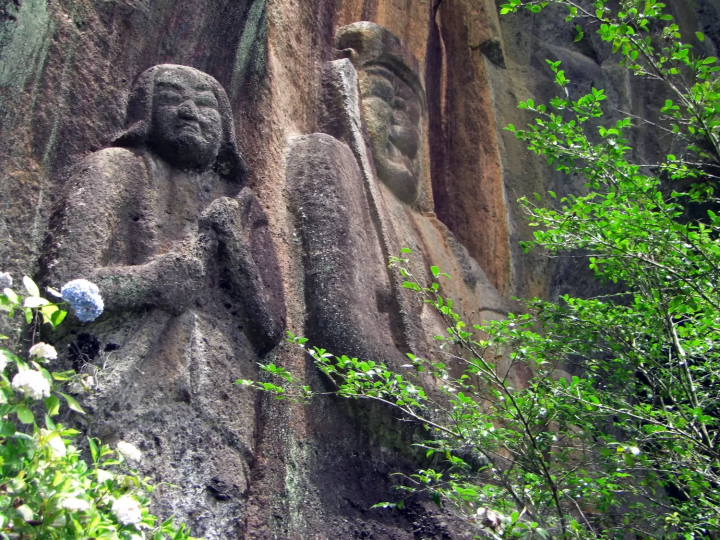
Picture courtesy of Oita Prefecture
On the Kunisaki Peninsula where such legends remain, there are still traces here and there of the Buddhist monks who trained in the mountains. For example, there are the Magaibutsu, figures of Buddhist saints and ascetic monks carved directly into rocky mountain facades. The Kunisaki Peninsula is home to the largest number of Magaibutsu relief carvings in Japan.
Furthermore, once every ten years, the Buddhist monks here engage in a form of mountain asceticism called Mineirigyo by embarking on a 160-kilometer-long pilgrimage route. This tradition is still carried on today.

The Kunisaki Peninsula's largest festival is the Shujo Onie Festival.
During this event, two men purify their bodies by jumping naked into the water, then a monk disguised as a demon dances with a torch in hand and prays for people's good health and a bountiful harvest for local farmers.
It's been said that Shujo Onie was a combination of a Heian Period New Year's event and Buddhist training that was being conducted on the Kunisaki Peninsula. It has been actively held since the early Edo Period.
It's not really known why this demon (Oni) appears as a good being in Kunisaki. However, it's believed that it might have a connection to the region's Shinbutsu Shugo culture. In 1977, Shujo Onie was designated as a National Important Intangible Folk Cultural Property and continues to be important to this day.
Shujo Onie Festival: Venues and Dates
Venues: Held at Tennenji Temple , Iwatoji Temple, and Jobutsuji Temple
(At Iwatoji Temple and Jobutsuji Temple they are held alternately every other year).
Date: January 7 on the lunar calendar (*On the modern calendar this falls somewhere between the end of January to February. Dates can change depending on the year).
To Join: Please refer to the Shujo Onie Festival Official Homepage.
Shujo Onie Festival: Our Full Report!

The main hall at Iwatoji Temple
We joined the Shujo Onie Festival that was held at Iwatoji Temple on January 28 (Saturday), 2023. On the day of the event, it snowed and temperatures dipped. However, the cold was equally matched by the passion and energy of the festival!
Shujo Onie is a long event that runs from about 15:00 until late at night. Read on to learn more about the highlights of this festival.
The Ice Cold Koritori Ritual to Purify One's Soul

The first highlight of the Shujo Onie Festival is Koritori, which is held in the early evening around 18:00.
When the time arrives, two naked men wearing only a traditional undergarment called fundoshi, emerge from the temple's main hall. Known as taireshi, these men are residents of the local region and play various roles during the festival.
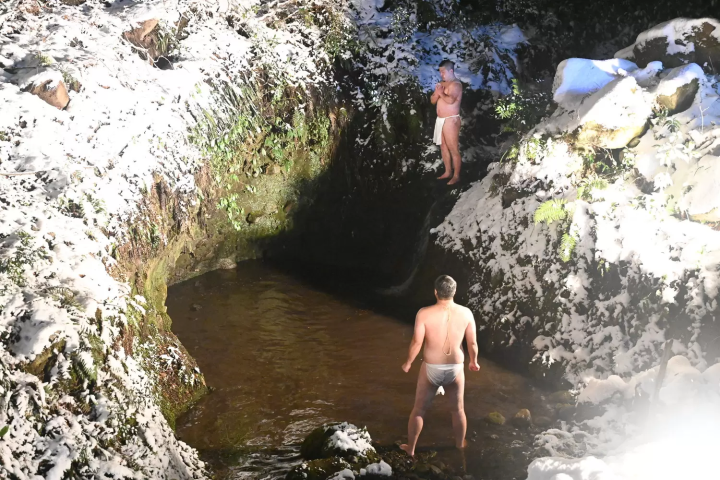
These two taireshi run through the grounds of the temple, then stop at the deep pool at the edge of the precincts and then put their hands together. Next, they each jump into the water to purify their body and soul.

It definitely takes courage to jump into the ice-cold waters on a snowy winter's evening!
"Good luck, Dad!" Words of encouragement can be heard from family members and other temple worshippers.

Then with steel resolve the men finally took the giant leap into the water! Those of us watching the events unfold seemed to be getting colder by the minute, but interestingly, the men who jumped into the water commented on how unexpectedly warm it was. Koritori brings to mind the severity of the ancient Buddhist monks' training. But with tonight's challenge, these men had radiant, glowing expressions.
Taiage: Raging Bonfires
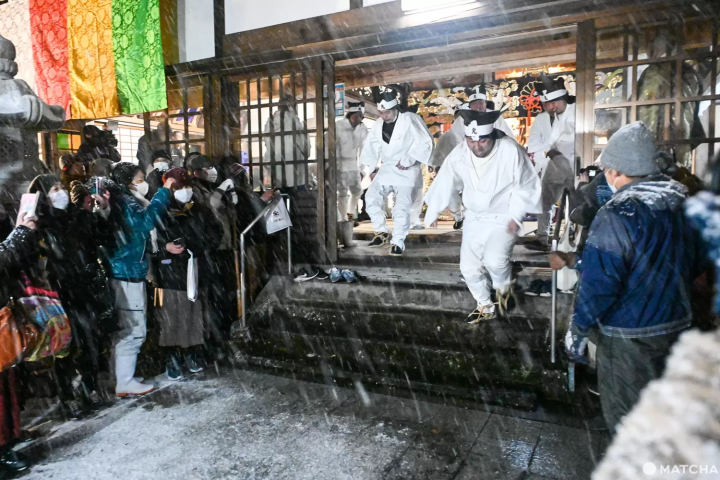
After Koritori, a monk and the taireshi exchange cups in the main hall and pray for a safe and successful Shujo Onie Festival, then the taireshi dash outside!

Next, with the help of local residents, giant torches are lit in a ceremony called Taiage.

The torches used during Taiage are immense, about three to four meters long."Take this over there!" "Send more over here!" The taireshi call out to each other, and working together they light the torches using the bonfire.

After the torches are lit, they are carried over to a place near the main hall, then over there they perform a ritual for the Buddhist statue in which they rotate the torches three times to the left, three times to the right, and then shake them up and down three times. Known as San San Kudo No Ho, repeating these three sets of three is said to be a good omen.
"Ready, set, go!" The sight of sparks flying in all directions as the taireshi call out a countdown and rotate the torches is a really powerful sight to see!

When this ritual is completed, the torches are held up toward the sky.
Tachiyaku: Warding Off Evil Spirits

After taiage, the evening sutra reading is performed in the temple's auditorium.

Next, Buddhist monks carry a pole (kosuibo) and perform a dance called Tachiyaku.
Part of Tachiyaku involves a walking-in-place kind of dance as the monks pray for a bountiful harvest (Maike) and for the safety of the lit torches (Kaibyaku).
After a series of dances, the chief priest and an elder monk from Iwatoji Temple take the stage. While casting a spell they hold a ritual (Shihogatame) which creates a barrier to ward off evil spirits.

The final part of Tachiyaku is a dance called Suzu Oni. Two Buddhist monks perform a dance while holding a bell and a special instrument (gohei) for Shinto rituals. This dance ushers in Onihashiri, the next highlight, and invites the main character Ara Oni to join the festivities.
Stomping Onihashiri and Flying Sparks

When Tachiyaku is finished, the Shujo Onie Festival's big climax, Onihashiri, gets underway!
First of all, the two monks appear as Arai Oni by wearing special masks. Then while singing, "oni hayo, raisho hayo," they hold torches and romp around inside the hall with the taireshi (our brave men who jumped into the ice-cold water at the festival's start).
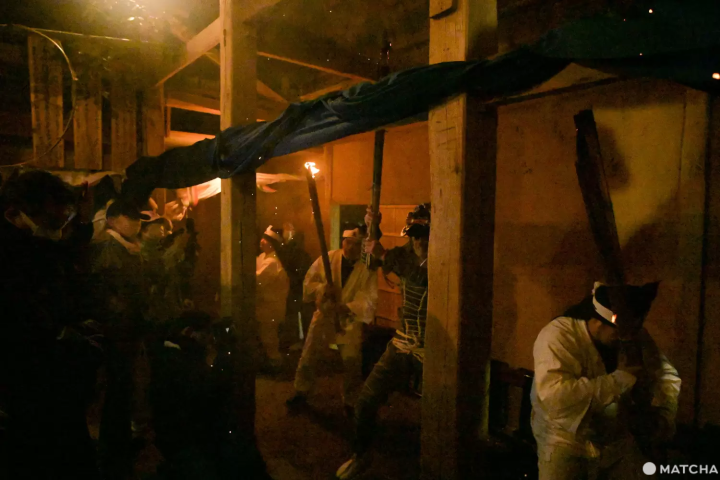
While this is going on, a torch collides with an interior column creating a shower of falling sparks!

Next, the taireshi and demons join hands and form a circle, inviting the onlooking worshippers to come into the middle.
When the worshippers step inside the circle, the taireshi and demons start moving around and around as they chant the Heart Sutra! While listening to these Buddhist sutras as the torches burned brightly, our writer started feeling dizzy; the heat inside was intoxicating.

After reciting the Heart Sutra, the demons stop what they were doing, then tap the shoulders and backs of the worshippers with their torches. This is a Kaji prayer to ask for the good health of these worshippers.
Virtually all of the worshippers receive this prayer.

When the worshippers receive their prayers, the demons and taireshi rush out of the building and run around the temple precincts (*2). Afterward, they all return back and the 2023 Shujo Onie Festival comes to a close.
Amidst the snow and cold temperatures, the festival continued until late at night. But the energy and vitality that we received created a truly satisfying experience that made us want to join again in the future.
*2: During the traditional Shujo Onie Festival, the demons rush out of the temple and visit homes in the region. After receiving the hospitality of local residents, the demons return to the temple. Due to COVID-19, an abbreviated version of Shujo Onie was held in 2023.
Onie no Sato History Museum

Picture courtesy of Oita Prefecture
The Shujo Onie Festival is only held once a year. However, at the Kunisaki Peninsula's Onie no Sato History Museum, visitors can get in touch with the festival's culture throughout the year.
Here, in addition to tools and artifacts from the festival, you can enjoy an audiovisual presentation of Shujo Onie in the theater and a video highlighting the Rokugo Manzan culture.
Onie no Sato History Museum
Location: Oita, Bungotakada, Nagaiwaya 1152
Hours of Operation: 9:00-17:00 (From December to March, 9:30-16:00)
Price: Adults 300 yen, children 150 yen
Official Website: Onie no Sato History Museum
Kunisaki Peninsula Highlights and Places to Visit

Formerly the property of Usa Jingu Shrine, Tashibu-no-Sho is a scenic area with terraced rice paddies. Located in the Kunisaki Peninsula's Usa Region, it was designated as a Globally Important Agricultural Heritage System.
Picture courtesy of Oita Prefecture
In addition to the Shujo Onie Festival, the Kunisaki Peninsula offers many other highlights including temples and shrines related to the Rokugo Manzan culture. Next, we'd like to introduce some particularly popular spots.
Usa Jingu Shrine
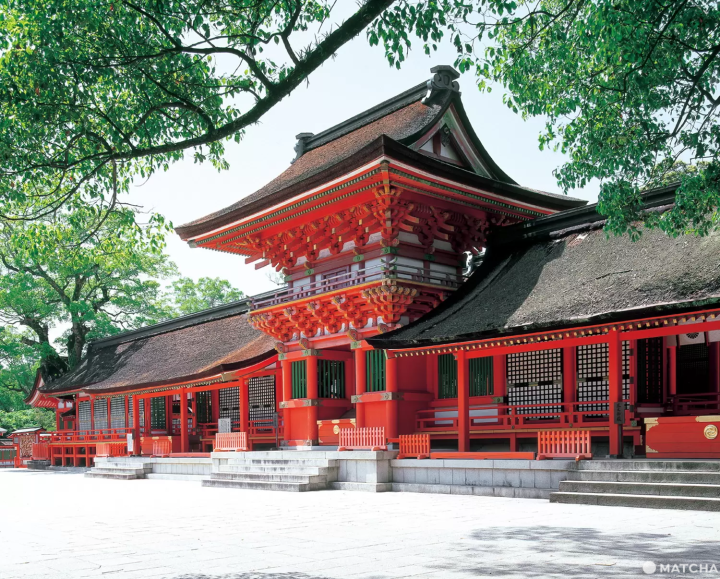
Picture courtesy of Oita Prefecture
In Japan, there are approximately 110,000 shrines. Among these, some 40,000 of them enshrine the deity Hachiman-O-Kami, and Usa Jingu Shrine serves as the head shrine. Usa Jingu Shrine is highly valued because it was originally thought to be the second mausoleum (a place where the spirits of ancestors are enshrined) after Ise Jingu Shrine. Ise Jingu Shrine was dedicated to the ancestral deities of the Imperial Family.
Many regions in the Kunisaki Peninsula were once owned by Usa Jingu Shrine. This shrine has many fascinating architectural highlights, starting with the main shrine building (honden) which was designated a national treasure.
Usa Jingu Shrine
Location: Oita, Usa, Minamiusa 2859
Hours of Operation at the Upper Shrine (Jogu): 5:30-19:00 (From October to March, 6:00-19:00)
Official Website: Usa Jingu Shrine (Japanese)
Monjusenji Temple

It was said that Monjusenji Temple was established in 648 by the famous ascetic En no Gyoja. He was the founder of Shugendo, a Buddhist sect that undertakes ascetic mountain training.
Monjusenji Temple enshrines Monju Bosatsu, the Buddha of wisdom, and is considered to be one of the famous Three Japanese Temples Worshipping Monju Bosatsu. The shrine also features a hidden Buddhist statue that's only on display once every 12 years.
Monjusenji Temple, surrounded by steep rock walls and a forest lined with Japanese zelkova and cedar trees, was also designated as a National Location of Scenic Beauty. Due to its location, this temple made us think about the strict training that the monks engaged in.
Monjusenji Temple
Location: Oita, Kunisaki, Kunisakimachi, Daionji 2432
Visiting Hours: 9:00-16:30
Official Website: Monjusenji Temple (Japanese)
Futagoji Temple

Picture courtesy of Oita Prefecture
Futagoji Temple was said to have been built by the Buddhist ascetic Ninmon in the year 718. As Rokugo Manzan's central temple, it came to oversee the temples on the Kunisaki Peninsula after the Edo Period.
The expansive temple grounds are blessed with an abundance of natural surroundings. It was even selected as one of Japan's 100 Best Locations for Forest Therapy.
The area also features seven curious spots. These include the Mumyo Bridge, said to awaken your faith if you cross over it, and Hashirimizu Kannon, a Buddhist statue that has water flowing out from under its feet. According to folklore, this water won't stop even during a drought.
Futagoji Temple
Location: Oita, Kunisaki, Akimachifutago 1548
Visiting Hours: 8:30-16:30
Admission: 300 yen
Official Website: Futagoji Temple (Japanese)
Kumano Magaibutsu: Buddhist Relief Carvings

Picture courtesy of Oita Prefecture
Kumano Magaibutsu is Japan's largest Buddhist image carved into a rock surface. It was designated as an Important Cultural Property of Japan.
On the left-hand side, you can see the firm facial features of Dainichi Nyorai, and the right-hand side shows a smiling Fudo Myoocarved into the surface. The flight of 99 stone steps leading from the torii gate all the way to the Magaibutsu was said to have been built in just one night by a demon in ancient times.
Kumano Magaibutsu
Location: Oita, Bungotakada, Tazume Hirano 2546-3
Hours of Operation: 8:00-17:00 (From November to March, 8:00-16:30)
Admission: 300 yen (Children and Junior High School students 150 yen)
Fukiji Temple

Picture courtesy of Oita Prefecture
Fukiji Temple is known as one of the Kunisaki Peninsula's top spots for viewing autumn foliage. Fukiji Temple's Oda Hall enshrines Amida Nyorai, and as the oldest existing wooden structure in Kyushu, it was designated as a national treasure.
In addition, along with Konjikido Golden Hall at Hiraizumi Chusonji Temple in Iwate and the Phoenix Hall at Kyoto's Uji Byodoin Temple, it is one of Japan's Three Halls dedicated to the Amida Buddha.
Fukiji Temple
Location: Oita, Bungotakada, Tashibufuki 2395
Visiting Hours: 8:30-16:30
Admission: 500 yen (Children and Junior High School students 150 yen)
Kunisaki Peninsula Access

When traveling to the Kunisaki Peninsula from such places as Tokyo, Osaka, or Nagoya, we recommend taking an airplane to Oita Airport. Located in Kunisaki City, the airport is conveniently close to Kunisaki Peninsula! You can find several hotels and car rental agencies nearby.
When heading here from within Kyushu, it's a good idea to rent a car in Fukuoka's Kitakyushu City or Oita City, since many areas of the Kunisaki Peninsula are not accessible by train or bus, we recommend touring the peninsula by rental car.
On the Kunisaki Peninsula, there is a Long Trail with a pilgrimage route called the Mineirigyo Trail serving as a base. Here you are also free to walk around. However, please keep in mind that there are very few accommodation facilities on the peninsula.
Sponsored by Monjusenji Temple
MATCHA's promotional account for corporate and local government advertising. We aim to provide useful information to our readers in an enjoyable manner.





























![[2026] Top 5 Strawberry Picking Spots in Tokushima, Naruto| Farms and Access Guide for January to May](https://resources.matcha-jp.com/resize/720x2000/2025/03/06-227165.webp)


